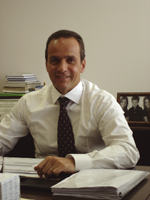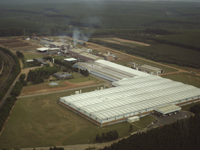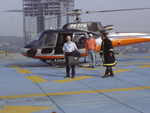A future in fibre
6 October 2008Often considered dated and environmentally unfriendly, wet process hardboard barely features in today’s global portfolio of wood based panel producers.
Except, that is, among some large panel makers in South America and their many customers around the world. These companies argue that, with adequate environmental safeguards, their good quality, competitively-priced thin board will continue to feed a rich global niche market for some years to come.
Among the board’s staunchest defenders is Brazilian eucalypt particleboard and hardboard maker Eucatex SA of São Paulo. Despite being hit by the US downturn, its two big Washington Ironworks press lines are this year feeding new export demand from the likes of Russia and Ukraine.
But, like its fellow Brazilian hardboard maker Duratex SA, Eucatex is hedging its bets ready for the day when their traditional product finally fades into panel history.
Work is progressing on an US$81m Eucatex project to install a 250,000m3/year Dieffenbacher continuous press line to make high density fibreboard (HDF) at its Salto site. The new dry line can also produce thin MDF.
Located near Salto’s wet process lines, it is set to turn out board from May or June 2009, according to Eucatex’s youthful executive vice-president José Antonio Goulart de Carvalho.
Eucatex, which only recently emerged from Brazil’s equivalent of the US Chapter 11 bankruptcy protection, has long wished to broaden its portfolio to include MDF, but it is reluctant to join the Brazilian industry’s latest capacity stampede to add large volumes of standard thickness MDF.
Rather, the group saw its chance to focus on thin fibreboard. For Eucatex, this has immediate attractions, not least because it is a Brazilian market leader in doors, laminate flooring and wall partitions. Thin board is also essential in furniture such as drawer bottoms and wardrobe backs, it points out.
In addition, with uncertainty as to just how soon the rush of new MDF capacity will be absorbed in Brazil, thin board offers a better export prospect, Jose Antonio Goulart de Carvalho told WBPI in an interview in São Paulo.
“We saw this opportunity and planned a very effective, competitive project. I think ours will be one of the most competitive plants in Brazil for thin HDF,said the Eucatex executive vice president.
Dominated by its 21m Dieffenbacher press, with a width of 2.75m, the new HDF line will include wood preparation and refining sections from Metso, glue kitchen and blending units from Pal and Imal and saws, transport and finishing operations supplied by the Italian
company EMG.
This addition to its broad product portfolio will help Eucatex regain market share, lost over the period of Chapter 11, and its capital restructuring; company progress was set back around two years due to its financial troubles, admitted José Antonio Goulart de Carvalho.
The HDF unit was not the only scheme the group was hatching up during its recovery process.
Eucatex is considering a bolder plan to build a 500,000m3/year eucalypt MDF plant, but raw material remains the biggest challenge. Wood and land prices are still soaring, especially in Eucatex’s home state, as potential tree plantation land is being snapped up for biofuel crops.
The firm has looked at possible sites in southern Brazil, but may still locate a new line at its Botucatu site in western São Paulo state.
Further west still, it has identified promising potential wood sources in the verdant state of Mato Grosso do Sul – translated, its name means ‘Thick Southern Forest’. That resource could sustain a plant in the state.
However, the executive vice president stressed, it is too early to reveal formal plans. Eucatex has studied the domestic market prospects and believes it could grow at up to 10-15% a year to 2012, absorbing all the new capacity now going in. But there is still some uncertainty on the demand side.
“We are focusing on finishing the HDF line and putting it to work. When we start to see the end of that project, we will
have a chance to see how the market is reacting.”
Any greenfield project, along with its supporting forest, means big investment – up to US$250m, he suggested.
One further project, born from the group’s review during its recovery period, is set to reinforce the efficiency of its new Salto HDF line. At a time of spiralling raw material costs, Eucatex has gone into waste wood recycling in a big way.
Taking advantage of Salto being close to Brazil’s commercial hub of São Paulo, and the city of Campinas, it boosted the capacity of a small recycling plant. Today, it is able to turn out up to 20,000 tonnes of material a month, both to fuel energy output and for use in panel production.
With an investment of around US$15m, Eucatex is already making big cost savings running its hardboard lines. Eighty per cent of the 10,000 tonnes of current monthly waste wood output is helping to fuel its energy needs, with the residue going into panel production.
The firm gathers high grade waste in 320 skips of 15-tonnes each from a range of urban sites such as vehicle assembly plants, big stores and ports within a radius of 150km around Salto.
Eucatex strictly monitors waste quality, and depending on this and the distance wood has to be trucked to the plant, pays varying sums for material under long-term contracts with suppliers.
Its motives for recycling were the soaring cost of wood and its limited plantation resource – reduced further when it paid off part of its bank debts with forest land. Now, it is the national industry’s biggest wood recycler.
With growing demand from the new HDF line, Eucatex will utilise much of its remaining recycling capacity. At full capacity, it expects to raise the volume of waste used in panel production up to 30% of the (recycling) unit’s output, according to José Antonio Goulart de Carvalho.
“When we achieve the capacity we’re planning, we will be saving more or less 12,000ha of forest plantation [by recycling],he predicted.
In July, when WBPI paid a ‘whistle-stop’ helicopter visit to Eucatex sites, major works were underway at Salto. Apart from the progressing HDF line, a huge new area was being carved out to allow significant expansion of the woodyard.
Salto is at the heart of what makes Eucatex distinctive – its focus on the design and development of a wide range of value-added finished products. With an eagle eye on niche market openings, it offers an array of printed, painted and laminated panel finishes. “The finished product is our strength,declared the executive vice president.
At the Botucatu site too, we found an air of change and refurbishment at Eucatex’s 360,000m3/year medium density particleboard (MDP) plant. The firm is working on its highly productive Bison Hydro-Dyn board line, investing in panel forming and finishing. “We aim to upgrade and improve the efficiency of the line and board finish,explained Eucatex’s consultant Paulo Amanthea.
Last November, it invested around US$9.3m to install a new nine million m2/year Wemhöner melamine laminating line alongside its Barberàn finish foil line. In December (08), Botucatu will get a new US$6m Tocchio impregnation line and an old Dieffenbacher melamine line will be upgraded and switched to Salto.
Despite all the new spending, Eucatex is still committed to hardboard. It has invested heavily in water treatment at Salto and considers its plant environmentally friendly.
Its executive vice president accepts that one day wet process hardboard will die out. But, so long as global demand continues and there is still life in its quality, low-cost product, Eucatex will keep the lines running.



